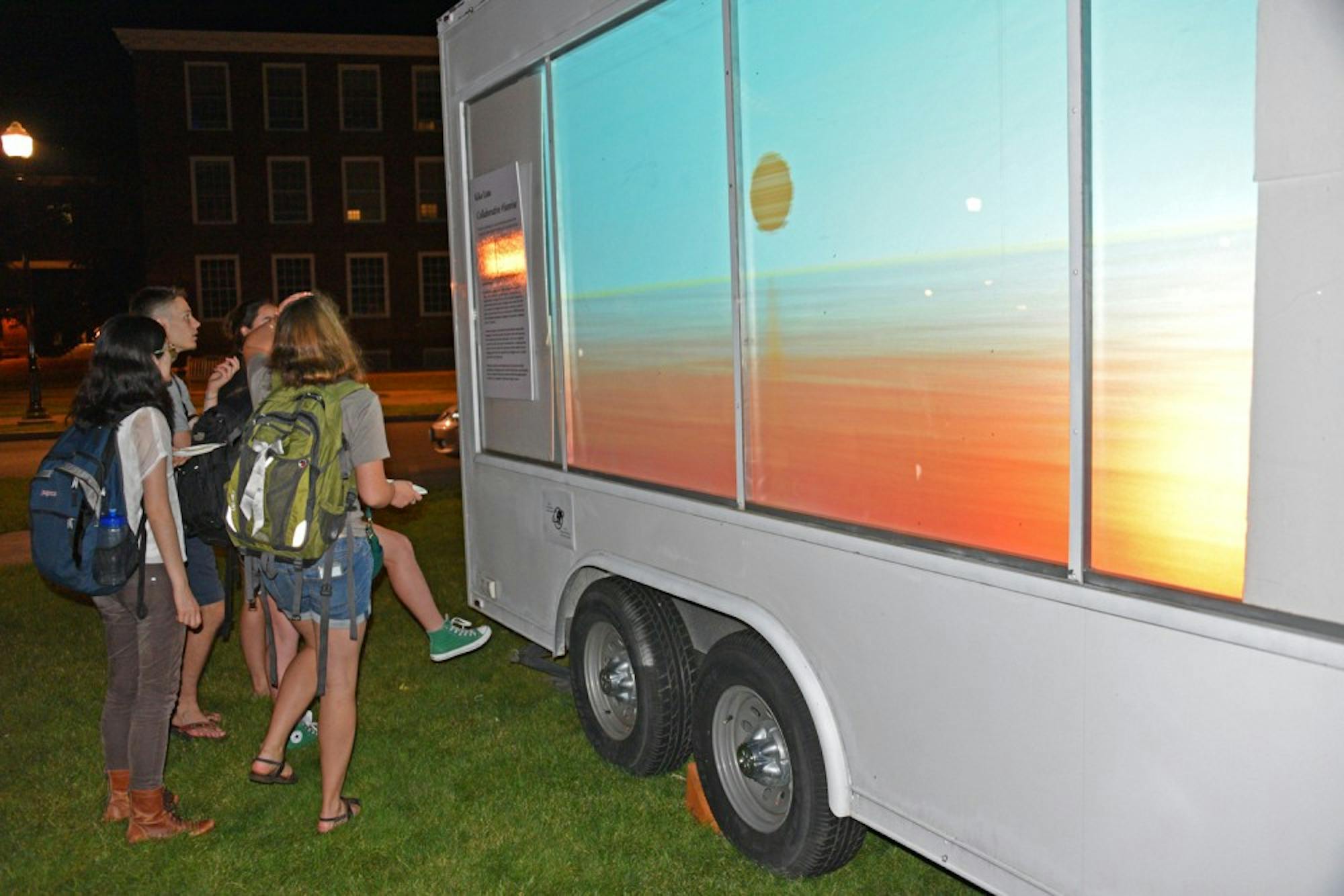After months of designing, coding and re-coding programs for her masters thesis in digital arts, Kiko Lam ’14 held an opening reception for “Collaborative #Sunrise” to a small crowd of friends, classmates and mentors on Monday night. The piece, a computational art installation that draws on themes of nature, color, time and social connectedness, uses Instagram photos from around the world to create an ever-changing image of what Lam calls an “eternal sunrise.”
Although Lam studied economics as a Dartmouth undergraduate, she decided to focus on computing and design after taking introductory programming courses during her senior year.
“I took [Computer Science] 1 and 10 and it completely changed my path,” Lam said.
She enrolled in the computer science department’s digital arts masters program last fall, and completed “Collaboration: Sunrise,” which was supported and funded by the Neukom Institute for Computational Science, the Digital Arts Leadership and Innovation Lab and the computer science department, as a culminating experience.
The project was inspired by a time-lapse video of a sunrise, which Lam recorded during a trip to Ecuador.
“I thought, ‘These colors are so beautiful,’ and people don’t get up to see the sunrise enough,” she said. “So I wanted to bring it to them.“
The first component of the project, which Lam finished this past spring, is a program that downloads Instagram photos with the hashtag “#sunrise” in real time and uses a machine learning algorithm to filter out advertisements and other unrelated content. Another computer algorithm extracts colors from the photos and channels them into a synthetic image of what the current sunrise looks like.
“After I finished that, I thought ‘How do I make people understand that these colors are actually coming from photos that were just uploaded by someone else,’” Lam said.
Thus, she began working on a second component — a mechanism that pins the Instagram photos used to create the synthetic sunrise onto a world map, based on associated geo-location information. The installation itself consists of 5 by 14 foot images of both the map and artificial sunrise projected onto both sides of a trailer called the “playcube,” which Lam obtained from the Tiltfactor Lab.
Two of Lam’s thesis advisors noted that an art installation is not the typical format for presenting computer science work.
“It’s different to do a public installation,” Tim Tregubov, a computer science technical staff member and a mentor to Lam’s work, said. “It brings design and development together, and the MSDA program is really about that — taking computer science and applying it to art.”
Computer science research professor Lorie Loeb, who also mentored Lam, reiterated this sentiment and added that an outdoor art installation is “unusual” even in the digital arts program.
Lam said that she enjoyed creating something with an artistic focus because it allowed her to connect more closely with a diverse audience.
“I had to make sure it wasn’t just for me — that it was an experience that other people could understand as well,” Lam said. “It’s not something that you need to be technical or computational to understand and be a part of.”
Indeed, students and community members of varying technical backgrounds crowded around the installation throughout the week to view Lam’s work.
Ruby Hopkins ’17, who was walking by the installation and decided to stop and take a look, said she was able to appreciate “Collaborative #Sunrise” despite having never studied computer science.
“It’s a really cool idea,” she said. “You don’t really think about what’s going on in other parts of the world, so it’s nice seeing exactly where [the sunrise] is happening at a given time.”
Another onlooker, computer science major Ryan Amos ’16, discussed the computational challenges of creating the programs with Lam and commented on the approachability of the piece.
“It’s often a problem that technology is not super accessible, so it’s great to see technology used to reach out to lots of different people,” he said.
Lam said that broad accessibility was a primary objective in creating her thesis. She said she also focused on helping individuals connect with nature, as well as with other people from around the world.
“People are interested in the idea that we all live in different time zones, and I kept coming back to the theme of nature and how daylight happens at different times around the Earth,” Lam said.
Loeb noted that the project is interdisciplinary in nature and addresses several themes.
“What’s great about [“Collaborative #Sunrise”] is that it happens at the intersection of computation and art,” Loeb said. “It has this social media element, and a real-time element and it connects us with people around the world.”
After presenting her thesis work to the general public, Lam said she enjoyed seeing people’s reactions to and enthusiasm for the piece.
“Of course I think the project is a good idea — I’ve been working on it for so long,” Lam said. “But I’m definitely happy to see that it’s something people are actually interested in.”
After graduating from the masters program this summer, Kiko will begin work as a consultant for a tech company in Washington, D.C. She said she hopes to use her skills to communicate across disciplines and bring technology closer to the public.




